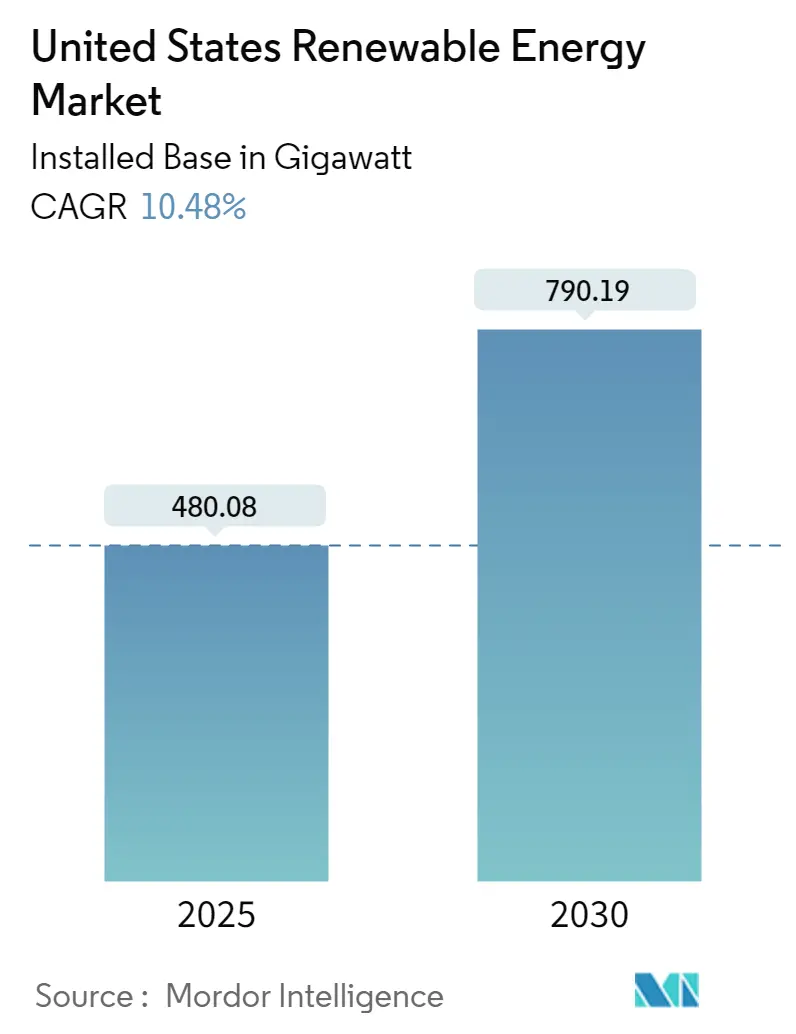
| Study Period | 2019 - 2030 |
| Base Year For Estimation | 2024 |
| Forecast Data Period | 2025 - 2030 |
| Market Volume (2025) | 480.08 gigawatt |
| Market Volume (2030) | 790.19 gigawatt |
| CAGR | 10.48 % |
| Market Concentration | Medium |
Major Players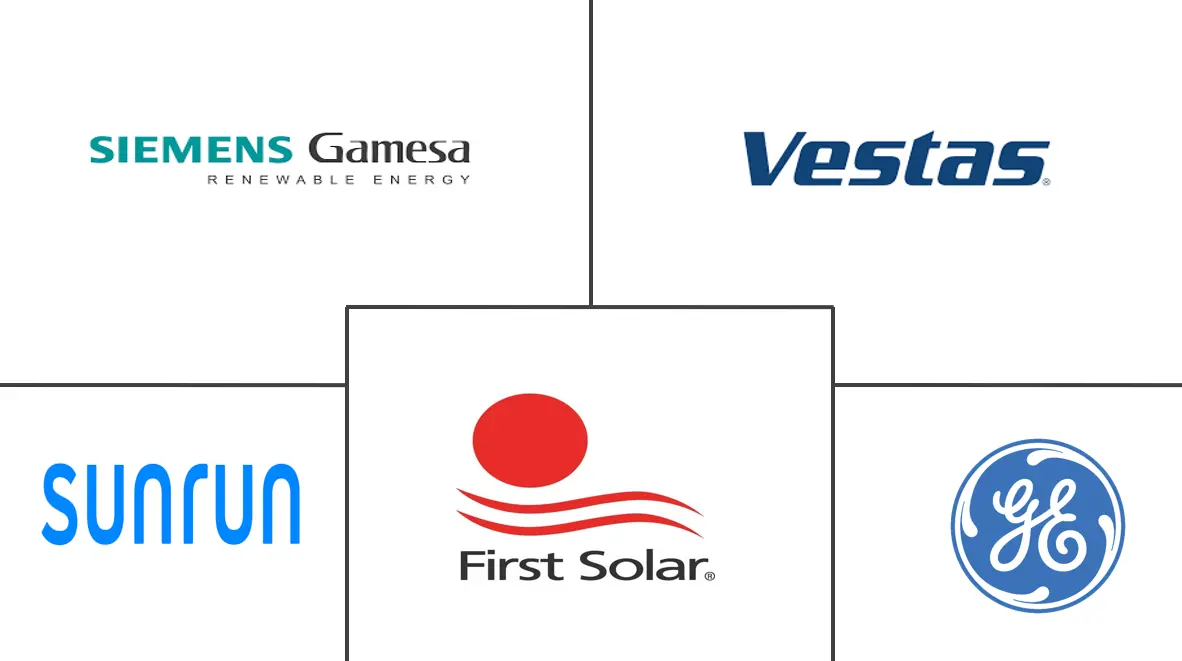
*Disclaimer: Major Players sorted in no particular order |
United States Renewable Energy Market Analysis
The United States Renewable Energy Market size in terms of installed base is expected to grow from 480.08 gigawatt in 2025 to 790.19 gigawatt by 2030, at a CAGR of 10.48% during the forecast period (2025-2030).
- Over the medium term, factors such as increasing solar and wind energy installations, supportive government policies, declining solar panel costs, and additional subsidies on renewables are expected to drive the renewable energy market during the forecast period.
- On the other hand, factors like a booming natural gas market competing with renewable energy and the limited energy supply from variable renewable energy sources are a few factors expected to restrain the US renewable energy market during the forecast period.
- Nevertheless, the US government announced a framework to invest USD 555 billion in funding for clean energy programs. This is expected to be an opportunity for the country's renewable energy market.
United States Renewable Energy Market Trends
Solar Energy to Witness Significant Growth
- The solar power industry in the United States has become increasingly accessible and widespread, reaching new heights in 2023. According to the Solar Energy Industries Association (SEIA), the US solar industry added an impressive 32.4 GW of new electric generating capacity in 2023, marking a significant milestone.
- This growth was observed across all solar market segments, leading to a total installed capacity of around 188 GW nationwide. The utility-scale industry played a crucial role, contributing 22.5 GW of new capacity, while nearly 800,000 US citizens installed solar systems in their homes.
- The United States aims to install an average of 30 GW of solar capacity annually until 2025, with plans to ramp up to 60 GW per year from 2025 to 2030. This ambitious goal is expected to drive rapid development in the solar photovoltaic (PV) market, with cumulative solar installed capacity expected to reach 673 GW by 2034, enough to power over 100 million homes.
- A notable project underscoring this growth is the Edwards & Sanborn Solar + Energy Storage project, launched by Terra-Gen and Mortenson in January 2024. This massive renewable energy endeavor spans 4,600 acres and includes 1.9 million First Solar panels, with a solar capacity of 875 megawatts direct current (MWdc) and nearly 3.3 gigawatt-hours (GWh) of energy storage. It also features a 1.3 GW interconnection capacity, making it the largest in the United States.
- The solar energy industry's rapid growth can be attributed to favorable government policies, such as the Solar Investment Tax Credit, declining costs, and increasing demand for clean electricity across private and public sectors.
- For instance, in June 2023, the US Environmental Protection Agency (EPA) launched a USD 7 billion grant competition under President Biden's Investing in America initiative. This program aims to enhance access to affordable, clean solar energy for millions of low-income households. The Solar for All competition, funded by the Greenhouse Gas Reduction Fund established by the Inflation Reduction Act, will award up to 60 grants to various entities, including states, municipalities, tribal governments, and nonprofit organizations, to develop and expand programs that support residential solar in underserved and low-income communities.
- Further illustrating this momentum, in April 2023, the Virginia State Corporation Commission (SCC) approved almost two dozen additional solar and energy storage projects to help meet the expanding needs of Dominion Energy Virginia customers. When completed, the projects will generate more than 800 megawatts (MW) of carbon-free electricity, which will be enough to power about 200,000 Virginian homes at full capacity. Consumers are expected to save more than USD 250 million in gasoline over the first ten years of operation because renewable energy does not require fuel.
- Therefore, increasing investments in the sector are expected to drive the US renewable energy market during the forecast period.
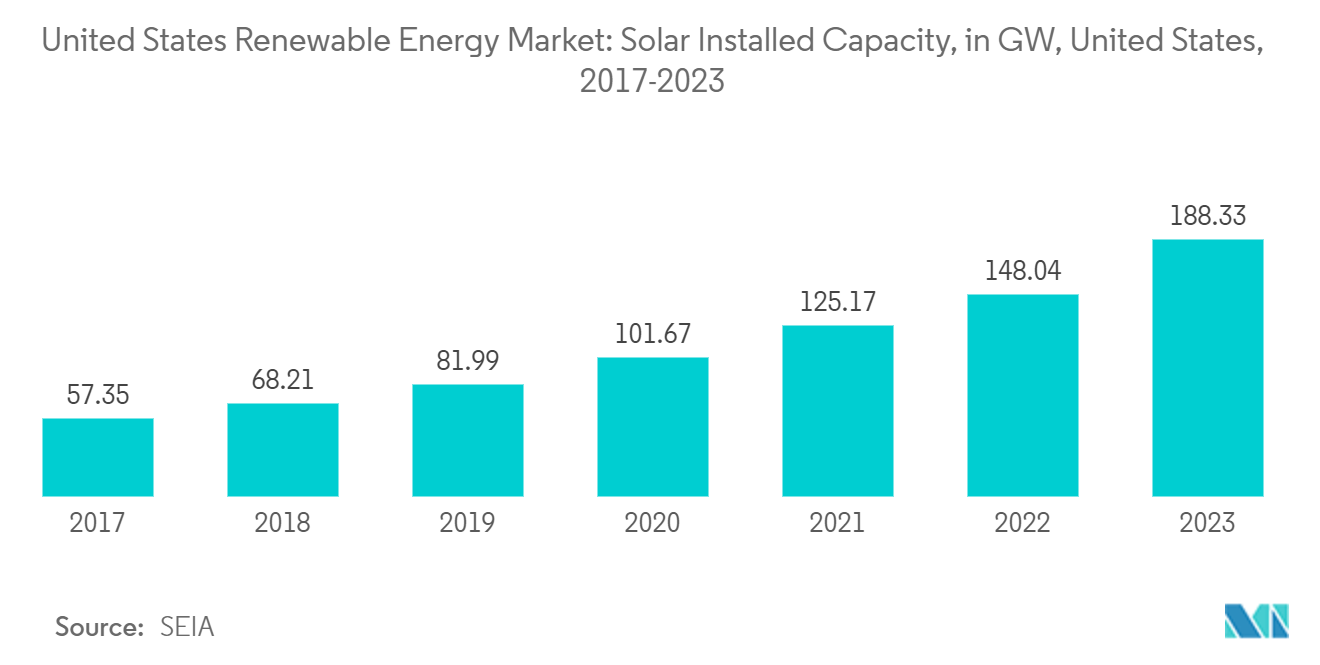
Supportive Government Policies to Drive Market Demand
- Government policies, such as tax credits, grants, and subsidies, can significantly reduce the upfront costs of renewable energy installations. These incentives make renewable energy projects more financially viable and attractive to investors, driving market growth.
- For instance, in March 2023, the US Department of Agriculture (USDA) revealed that starting from April 1, applications would be accepted for grants worth USD 1 billion. These grants specifically aim to assist agricultural producers and rural small businesses in investing in renewable energy systems and implement energy-efficiency improvements.
- In 2021, the United States committed to achieving a 50% to 52% reduction in greenhouse gas pollution compared to 2005 levels by 2030. The United States has also pledged to transition to a carbon-neutral economy by 2050.
- With these supportive policies, the installed capacities of renewable energy have grown significantly in recent years in the country. According to the US Energy Information Administration, the electricity generated through renewable energy was around 23% of the total electricity generated. This capacity is expected to increase further due to the government's various auctions for renewable energy.
- For instance, in June 2023, under the Department of the Interior, the Bureau of Land Management conducted an auction for utility-scale solar energy development in Nevada, raising USD 105.15 million in top bids. The auction involved four parcels spanning 23,675 acres in the Amargosa Desert, potentially adding nearly 3 GW of renewable energy to the electrical grid.
- Further, in April 2024, the US Department of the Interior revealed two proposed auctions for offshore wind energy development, one off the coast of Oregon and the other in the Gulf of Maine.
- Therefore, supportive government policies are expected to drive the renewable energy market in the United States during the forecast period.
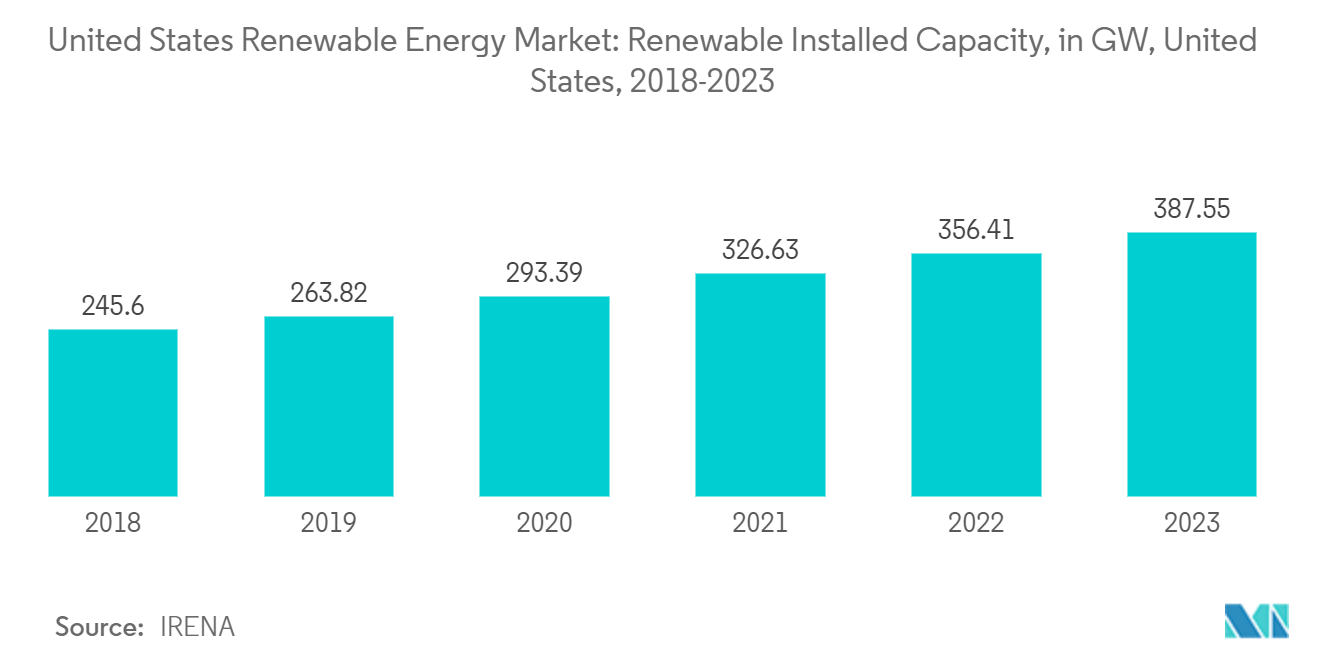
United States Renewable Energy Industry Overview
The US renewable energy market is fragmented. Some of the major players in the market (in no particular order) include Vestas Wind Systems AS, Siemens Gamesa Renewable Energy SA, General Electric Company, First Solar Inc., and Sunrun Inc.
United States Renewable Energy Market Leaders
-
Vestas Wind Systems A/S
-
Siemens Gamesa Renewable Energy S.A.
-
First Solar Inc.
-
Sunrun Inc.
-
General Electric Company
- *Disclaimer: Major Players sorted in no particular order
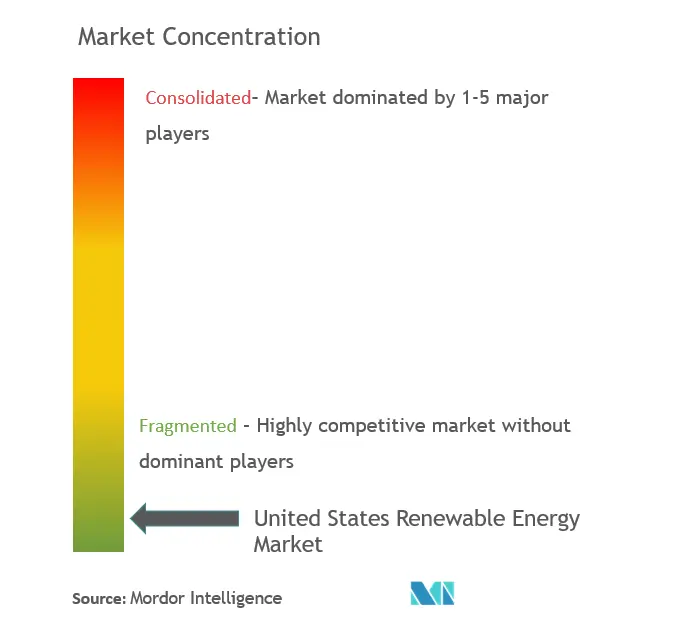
United States Renewable Energy Market News
- November 2023: The Biden-Harris administration authorized the Empire Wind offshore wind project, marking President Biden's sixth approval of a large-scale offshore wind energy project. This decision aligns with the administration's objective of installing 30 GW offshore wind energy capacity by 2030.
- November 2023: The US Department of Energy (DOE) announced the Puerto Rico Energy Resilience Fund (PR-ERF), which will provide up to USD 453.5 million to increase residential rooftop solar PV and battery storage installations across the region, with a focus on reaching and supporting Puerto Rico's most vulnerable residents. This round of funding will support consumer protection and education initiatives to support the long-term use of solar systems by residents, as well as a Solar Ambassador Prize for community groups to assist the Department in identifying and connecting with eligible households, thereby assisting Puerto Rico and President Biden in meeting their goals of lowering energy costs through a resilient grid powered by 100% renewable energy.
United States Renewable Energy Industry Segmentation
Renewable energy refers to energy derived from naturally replenishing sources that are virtually inexhaustible and have minimal environmental impact. Unlike finite fossil fuels, which contribute to climate change and pollution, renewable energy sources can be sustainably harnessed to meet the world's energy needs.
The US renewable energy market is segmented into source. By source, the market is segmented into wind, solar, hydropower, bioenergy, and other sources.
For each segment, the market sizing and forecasts have been done based on installed capacity (GW).
US Renewable Energy Market Research FAQs
How big is the United States Renewable Energy Market?
The United States Renewable Energy Market size is expected to reach 480.08 gigawatt in 2025 and grow at a CAGR of 10.48% to reach 790.19 gigawatt by 2030.
What is the current United States Renewable Energy Market size?
In 2025, the United States Renewable Energy Market size is expected to reach 480.08 gigawatt.
Who are the key players in United States Renewable Energy Market?
Vestas Wind Systems A/S, Siemens Gamesa Renewable Energy S.A., First Solar Inc., Sunrun Inc. and General Electric Company are the major companies operating in the United States Renewable Energy Market.
What years does this United States Renewable Energy Market cover, and what was the market size in 2024?
In 2024, the United States Renewable Energy Market size was estimated at 429.77 gigawatt. The report covers the United States Renewable Energy Market historical market size for years: 2019, 2020, 2021, 2022, 2023 and 2024. The report also forecasts the United States Renewable Energy Market size for years: 2025, 2026, 2027, 2028, 2029 and 2030.
Our Best Selling Reports
US Renewable Energy Industry Report
The US Renewable Energy Market is poised for significant growth, driven by supportive government policies and initiatives aimed at increasing electricity demand from renewable sources such as wind, hydropower, solar, biomass, and geothermal energy. The market is segmented by type, including solar, wind, biofuel, hydropower, and others, with the solar segment expected to hold a key share due to the rising number of solar projects. The market caters to various end users, including industrial, residential, and commercial sectors.
Key factors contributing to market growth include increasing solar and wind energy installations, declining solar panel costs, and additional subsidies on renewables. However, challenges such as the booming natural gas market and the limited energy supply from variable renewable energy sources may impact market expansion.
The industry analysis reveals that the market growth is supported by industry statistics and industry trends. The industry outlook remains positive, with market data indicating a promising future. The market forecast suggests continued growth, driven by market leaders and their strategic initiatives. The market overview highlights the current state of the market, while market segmentation provides insights into different market segments.
Industry reports and market reports offer detailed insights into the market structure and market value. Research companies contribute to industry research, providing valuable industry information and industry size estimates. The market predictions and market review suggest a robust market outlook, with market growth driven by various factors.
The report example and report pdf provide comprehensive data, enabling stakeholders to make informed decisions. The industry trends and industry statistics underscore the dynamic nature of the market, while the industry size and market value reflect the market's economic significance. The market leaders continue to play a pivotal role in shaping the market's future, supported by industry reports and market data.
In conclusion, the US Renewable Energy Market is set for substantial growth, driven by supportive policies, technological advancements, and increasing demand for renewable energy sources. The industry analysis and market forecast indicate a positive trajectory, with market leaders and research companies playing a crucial role in driving market growth. The market overview and market segmentation provide a detailed understanding of the market, while the report example and report pdf offer valuable insights for stakeholders.




